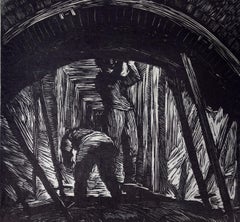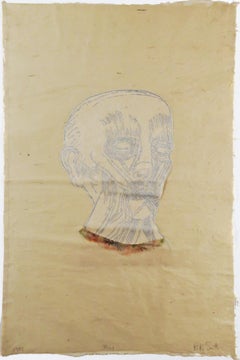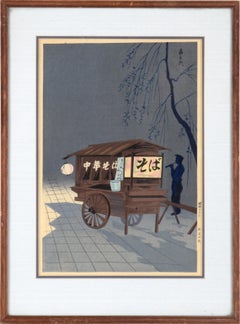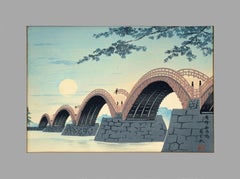Tomikichiro Tokuriki Art
1902-2000
Print artist. Tokuriki was born in Kyoto, where he has always worked. The last of a long line of traditional-style painters, he turned early to woodblock prints and became a leader of the Kyoto 'Sosaku Hanga'. He graduated from the Kyoto City School of Fine Arts and Crafts and then from the Kyoto City Specialist School of Painting in 1924. In 1928 he studied 'Nihonga' painting under Tsuchida Bakusen (1887-1936) and Yamamoto Shunkyo (1871-1933) and exhibited with Kokuga Sosaku Kyokai, but about the same time in 1929 he changed to woodblock printing under the influence of Hiratsuka Un'ichi and began to contribute to the early print magazine 'Han'. He was a member of Nihon Hanga Kyokai from 1932, and active in promoting 'Sosaku Hanga' in Kyoto. He was a co-founder of the Kyoto magazine 'Taishu hanga' in 1932, which helped create the sense of a local school of the Creative Print Movement much encouraged by Hiratsuka. He produced many sets of prints before and during the Pacific War based on traditional subjects, such as 'Shin Kyoto fukei' ('New View of Kyoto', 1933-4), which also included designs by Asada Benji (q.v.) and Asano Takeji (b.1900), and 'Tokyo hakkei' ('Eight Views of Tokyo', 1942). Most of these were published by Uchida of Kyoto, but after the war Tokuriki set up his own publishing company called Matsukyu, which also began to teach block-carving to artisans and artists, in later years many of them foreigners. In 1948 he also set up a sub-company called Koryokusha consisting of artists who would produce their prints under the financial umbrella of Matsukyu. Later sets include 'Hanga Kyoto hyakkei' ('One Hundred Print Views of Kyoto', 1975). Tokuriki has continued to be active in teaching and writing, producing a long series of articles on print techniques in 'Hanga geijutsu' magazine during the 1970s.to
2
Overall Width
to
Overall Height
to
2
2
2
2
2
1
1
1
1
2
2
9,475
2,689
1,375
1,358
2
Artist: Tomikichiro Tokuriki
Untitled, Horsewoman
By Tomikichiro Tokuriki
Located in San Francisco, CA
This artwork "horsewoman" c.1960 is an original woodcut by noted Japanese artist, Tomikichiro Tokuriki, 1902-1999. It is hand signed and numbered 47/100 in pencil by the artist. The image (Block mark) size is 15.35 x 20.35 inches, sheet size is 15.35 x 20.5 inches. It is in very good condition, hanging tape remaining on the back.
About the artist:
Print artist. Tokuriki was born in Kyoto, where he has always worked. The last of a long line of traditional-style painters, he turned early to woodblock prints and became a leader of the Kyoto 'Sosaku Hanga'. He graduated from the Kyoto City School of Fine Arts and Crafts and then from the Kyoto City Specialist School of Painting in 1924. In 1928 he studied 'Nihonga' painting under Tsuchida Bakusen (1887-1936) and Yamamoto Shunkyo (1871-1933) and exhibited with Kokuga Sosaku Kyokai, but about the same time in 1929 he changed to woodblock printing under the influence of Hiratsuka Un'ichi and began to contribute to the early print magazine 'Han'. He was a member of Nihon Hanga Kyokai from 1932, and active in promoting 'Sosaku Hanga' in Kyoto. He was a co-founder of the Kyoto magazine 'Taishu hanga' in 1932, which helped create the sense of a local school of the Creative Print Movement much encouraged by Hiratsuka. He produced many sets of prints before and during the Pacific War based on traditional subjects, such as 'Shin Kyoto fukei' ('New View of Kyoto', 1933-4), which also included designs by Asada Benji (q.v.) and Asano Takeji (b.1900), and 'Tokyo hakkei' ('Eight Views of Tokyo', 1942). Most of these were published by Uchida of Kyoto, but after the war Tokuriki set up his own publishing company called Matsukyu, which also began to teach block-carving to artisans and artists, in later years many of them foreigners. In 1948 he also set up a sub-company called Koryokusha consisting of artists who would produce their prints under the financial umbrella of Matsukyu. Later sets include 'Hanga Kyoto hyakkei' ('One Hundred Print Views of Kyoto', 1975). Tokuriki has continued to be active in teaching and writing, producing a long series of articles on print techniques in 'Hanga geijutsu' magazine during the 1970s.
Bibliography
Smith, Lawrence, 'Modern Japanese Prints 1912-1989: Woodblocks and Stencils', BMP, London, 1994, p. 36 and no. 50.Statler, Oliver, 'Modern Japanese Prints: An Art Reborn', Turtle, Rutland, Vermont, and Tokyo, 1956, pp. 118-22.Tokuriki, Tomikichiro (trans. Arimatsu, Teruko), 'Woodblock Printing', Arimatsu Color Book Series no. 14, 8th English edn, Hoikusha, Osaka, 1977.Kanagawa Prefectural Museum of Modern Art, 'Kindai Nihon no mokuhanga-ten', exh. cat., 1990.Merritt, Helen, 'Modern Japanese Woodblock...
Category
Mid-20th Century Other Art Style Tomikichiro Tokuriki Art
Materials
Woodcut
Untitled, Two Horsemen
By Tomikichiro Tokuriki
Located in San Francisco, CA
This artwork "Two Horsemen" c.1960 is an original woodcut by noted Japanese artist, Tomikichiro Tokuriki, 1902-1999. It is hand signed and numbered 38/100 in pencil by the artist. The image (Block mark) size is 15.25 x 20.5 inches, sheet size is 16.5 x 21.15 inches. It is in very good condition, hanging tape remaining on the back.
About the artist:
Print artist. Tokuriki was born in Kyoto, where he has always worked. The last of a long line of traditional-style painters, he turned early to woodblock prints and became a leader of the Kyoto 'Sosaku Hanga'. He graduated from the Kyoto City School of Fine Arts and Crafts and then from the Kyoto City Specialist School of Painting in 1924. In 1928 he studied 'Nihonga' painting under Tsuchida Bakusen (1887-1936) and Yamamoto Shunkyo (1871-1933) and exhibited with Kokuga Sosaku Kyokai, but about the same time in 1929 he changed to woodblock printing under the influence of Hiratsuka Un'ichi and began to contribute to the early print magazine 'Han'. He was a member of Nihon Hanga Kyokai from 1932, and active in promoting 'Sosaku Hanga' in Kyoto. He was a co-founder of the Kyoto magazine 'Taishu hanga' in 1932, which helped create the sense of a local school of the Creative Print Movement much encouraged by Hiratsuka. He produced many sets of prints before and during the Pacific War based on traditional subjects, such as 'Shin Kyoto fukei' ('New View of Kyoto', 1933-4), which also included designs by Asada Benji (q.v.) and Asano Takeji (b.1900), and 'Tokyo hakkei' ('Eight Views of Tokyo', 1942). Most of these were published by Uchida of Kyoto, but after the war Tokuriki set up his own publishing company called Matsukyu, which also began to teach block-carving to artisans and artists, in later years many of them foreigners. In 1948 he also set up a sub-company called Koryokusha consisting of artists who would produce their prints under the financial umbrella of Matsukyu. Later sets include 'Hanga Kyoto hyakkei' ('One Hundred Print Views of Kyoto', 1975). Tokuriki has continued to be active in teaching and writing, producing a long series of articles on print techniques in 'Hanga geijutsu' magazine during the 1970s.
Bibliography
Smith, Lawrence, 'Modern Japanese Prints 1912-1989: Woodblocks and Stencils', BMP, London, 1994, p. 36 and no. 50.Statler, Oliver, 'Modern Japanese Prints: An Art Reborn', Turtle, Rutland, Vermont, and Tokyo, 1956, pp. 118-22.Tokuriki, Tomikichiro (trans. Arimatsu, Teruko), 'Woodblock Printing', Arimatsu Color Book Series no. 14, 8th English edn, Hoikusha, Osaka, 1977.Kanagawa Prefectural Museum of Modern Art, 'Kindai Nihon no mokuhanga-ten', exh. cat., 1990.Merritt, Helen, 'Modern Japanese Woodblock...
Category
Mid-20th Century Other Art Style Tomikichiro Tokuriki Art
Materials
Woodcut
Related Items
"Mine Shaft", Soviet Union: An Early 20th C. Woodcut Engraving by Abramovitz
By Albert Abramovitz
Located in Alamo, CA
This is a signed woodcut engraving entitled "Mine Shaft" created by Albert Abramovitz in 1935, after a trip to the Soviet Union. It depicts two Russian workers constructing a mine sh...
Category
1930s Tomikichiro Tokuriki Art
Materials
Woodcut
$940 Sale Price
20% Off
H 13.38 in W 8.88 in
Untitled
By Kiki Smith
Located in New York, NY
Kiki Smith
'Untitled,' 1995
Woodcut with color additions by hand
31 x 21 inches
Edition 43 of 47
Signed
In 1995 five well-known American artists - Donald Baechler, Julian Lethbridge...
Category
1990s Tomikichiro Tokuriki Art
Materials
Woodcut
Midnight Wolf: A Limited Edition Clarence Mills Signed Haida Inuit Print
Located in Alamo, CA
"Midnight Wolf" is a framed signed limited edition abstract inuit native people's work by Northwest Coast Haida artist Clarence Mills. The print depicts a st...
Category
Late 20th Century Abstract Tomikichiro Tokuriki Art
Materials
Woodcut
$860 Sale Price
20% Off
H 26.88 in W 20.63 in D 0.88 in
Alex Katz from 'A Tremor in the Morning' signed, limited edition woodcut print
By Alex Katz
Located in San Rafael, CA
Alex Katz (b. 1927)
Untitled, from the portfolio 'A Tremor in the Morning', 1986
Woodcut on wove paper
Edition 32/45
Signed and numbered in pencil lower left
Sheet: 20 x 19.75 inches...
Category
1980s Contemporary Tomikichiro Tokuriki Art
Materials
Lithograph, Woodcut
$4,800
H 22.5 in W 22 in D 1.5 in
"Actor Kataoka Nazaemon as Oboshi Yaranosuke Leader of the 47 Ronin" Portrait
By Utagawa Kunisada (Toyokuni III)
Located in Austin, TX
Artist: Utagawa Kunisada "Toyokuni the Third" (Japanese 1786 - 1864)
Page Size: 14 x 9.5 in.
Frame Size: 21 x 16.25
Translation of Calligraphic Japanese Text:
大星由良之助 Ōboshi Yuranosu...
Category
Mid-19th Century Tomikichiro Tokuriki Art
Materials
Paper, Woodcut
Paul Jacoulet Le Marie Seoul, Coriée, Woodblock Print, 1948
By Paul Jacoulet
Located in Austin, TX
Paul Jacoulet ( France, Japan 1902 - 1960 )
Title: La Mariée Seoul, Corée
Medium: Woodblock Print
Size: 15.5 in. x 12 in.
Movement: Showa
Markings: Si...
Category
1940s Tomikichiro Tokuriki Art
Materials
Woodcut
$2,800
H 15.5 in W 12 in
"Skating on Ladies' Pond Central Park": Winslow Homer 19th C. Woodcut Engraving
By Winslow Homer
Located in Alamo, CA
This Winslow Homer woodcut engraving entitled "Skating on the Ladies' Skating-Pond in Central Park, New York", was published in Harper's Weekly in the January 28, 1860 edition. It depicts a large number of men, women and children skating on a recently opened pond in Central Park. At the time of publication of this engraving, Central Park was in the early stages of construction. This engraving documents the very early appearance of Frederick Law Olmstead and Calvert Vaux's masterpiece of landscape design. According to Olmsted, the park was "of great importance as the first real Park made in this century – a democratic development of the highest significance". The people of New York were very proud of the plans for their park. It was stated at the time: "Our Park, which is progressing very satisfactorily under the management of the Commissioners, will undoubtedly be, one of these days, one of the finest place of the kind in the world...Those who saw the Park before the engineers went to work on it are amazed at the beautiful sites which have been contrived with such unpromising materials; all fair persons believe that the enterprise is managed with honesty and good taste."
Skating was rapidly rising in national popularity in part due to the opening of Central Park’s lake to skaters on a Sunday in December 1858 with 300 participants. The following Sunday it attracted ten thousand skaters. By Christmas Day, a reported 50,000 people came to the park, most of them to skate. There were rules governing who could use the skating pond. “The Ladies’ Pond...
Category
1870s American Impressionist Tomikichiro Tokuriki Art
Materials
Engraving, Woodcut
$940 Sale Price
20% Off
H 23.13 in W 29.5 in D 1.13 in
Lord on the Sand Castle - XX century Black & White Woodcut Print
By Franciszek Bunsch
Located in Warsaw, PL
Illustration for Jules de la Medelen's "Lord on the Sand Castle" ("Le Marquis Des Saffras")
FRANCISZEK BUNSCH (born in 1926) Franciszek Bunsch was born in Bielsko in 1926. He studie...
Category
1950s Contemporary Tomikichiro Tokuriki Art
Materials
Woodcut, Paper
$317
H 2.56 in W 3.94 in
Lord on the Sand Castle - XX century Black & White Woodcut Print
By Franciszek Bunsch
Located in Warsaw, PL
Illustration for Jules de la Medelen's "Lord on the Sand Castle" ("Le Marquis Des Saffras")
FRANCISZEK BUNSCH (born in 1926) Franciszek Bunsch was born in Bielsko in 1926. He studie...
Category
1950s Contemporary Tomikichiro Tokuriki Art
Materials
Woodcut, Paper
$317
H 3.15 in W 4.14 in
"Daikoku, Dieu de la Richesse" Japanese Style Woodblock Print
By Paul Jacoulet
Located in Austin, TX
A woodblock print of a Japanese geisha in elegant clothing against a yellow decorative background.
By Paul Jacoulet
15.5" x 12" Woodblock print on paper
Framed Size: 22.5" x 18.5"
...
Category
Mid-20th Century Tomikichiro Tokuriki Art
Materials
Paper, Woodcut
$2,500
H 15.5 in W 12 in
Brutalist Graveside Scene Patriotic Dead Soldier, Gas Mask & Skeletons
By Nicholas Sperakis
Located in Exton, PA
Brutalist colored woodcut circa 1976 by Nicholas Sperakis. The image depicts skeletal figures around the grave of a soldier. Note the American flag features which drape the entombed ...
Category
1970s Expressionist Tomikichiro Tokuriki Art
Materials
Woodcut
$304 Sale Price
20% Off
H 38 in W 32 in D 1 in
EROTIC DREAM, Woodcut, Limited Edition, signed by the Artist
Located in Palm Desert, CA
"EROTIC DREAM" (1976) by Norbert Matzdorf
Woodcut print on paper
Limited Edition, numbered (10.3), dated and hand-signed by the artist
27,9 x 38,3 cm
Norbert Matzdorf (1951 – 2013) ...
Category
1970s Tomikichiro Tokuriki Art
Materials
Paper, Woodcut
$200
H 15.08 in W 10.99 in D 0.01 in
Previously Available Items
Soba Noodle Vendor Cart at Night - Japanese Woodblock in Ink on Paper
By Tomikichiro Tokuriki
Located in Soquel, CA
Soba Noodle Vendor Cart at Night - Japanese Woodblock in Ink on Paper
Clean and balanced depiction of noodle cart by Tomikichiro Tokuriki (Japanese, 1902-1999). The noodle cart is front and center, in full color, with a faint glow emanating from the sign. The vendor is standing silhouetted to the right of the cart, under a wispy tree.
Artist's signature along the right edge.
Signature in the upper right corner.
Presented in a wood frame with a light blue grey mat.
Frame size: 19.75"H x 14.5"W
Paper size" 15.38"H x 10.25"W
Tomikichiro Tokuriki (Japanese, 1902-1999) was born March 22, 1902, in Kyoto, Japan. The first teacher of the young Tomikichiro was his grandfather. Later he entered the Kyoto School of Arts and Crafts with a two-year preparatory class and four years of regular training, and later a three year training at the Kyoto College of Art. He graduated from Kyoto Art College in 1923.
While still at college, the young artist discovered his passion for sosaku hanga prints - a movement that had spread from Tokyo to Kyoto. With the assistance of an old carver and an Ukiyo-e printer, Tomikichiro Tokuriki learned everything to master the complete process of design, carving and printing himself.
While the artist published his creative hanga-style prints himself, the artisan-prints were published by Uchida, Unsodo and other Kyoto publishers.
Later he joined the Hanga Association and met other artists of the sosaku hanga movement like Hiratsuka, Masao Maeda, Kihachiro Shimozawa, Hide Kawanishi and Shiko Munakata.
Like so many Japanese artists of the twentieth century, he went on extensive travels throughout Europe and the United States. In the sixties, he opened several exhibitions of his artworks in major US cities like Chicago, New York, Pittsburgh and Cleveland. And of course, he used his trips abroad to make sketches.
Tokuriki Tomikichiro...
Category
1950s Edo Tomikichiro Tokuriki Art
Materials
Paper, Ink, Woodcut
H 19.75 in W 14.5 in D 0.5 in
"Suwa Kintai Bridge at Iwakuni", Mid Century Japanese Landscape Woodblock Print
By Tomikichiro Tokuriki
Located in Soquel, CA
"Suwa Kintai Bridge at Iwakuni", a beautiful mid-century Japanese woodblock print by master modern printmaker Tomikichiro Tokuriki (Japanese, 1902-2000), c.1960s. This iconic bridge of five arches is depicted in the traditional clean and minimalist style, with tiny figures silhouetted under a full moon. From the series "Hanga Nihon Hakkei" (The Eight Views of Japan).
Signed with the artist's chop lower right.
Signed with chop of publisher, Uchida Bijutsu Shoten, lower right margin.
"Suwa Kintai Bridge at Iwakuni / Hiroshima" noted on verso.
Displayed in a new grey mat with acid free foam core backing. Unframed.
Paper size: 11.25"H x 16"W.
Tokuriki was born in Kyoto, where he has always worked. The last of a long line of traditional-style painters, he turned early to woodblock prints and became a leader of the Kyoto 'Sosaku Hanga'. He graduated from the Kyoto City School of Fine Arts and Crafts and then from the Kyoto City Specialist School of Painting in 1924. In 1928 he studied 'Nihonga' painting under Tsuchida Bakusen (1887-1936) and Yamamoto Shunkyo...
Category
Mid-20th Century Modern Tomikichiro Tokuriki Art
Materials
Paper, Woodcut
H 14 in W 18.75 in D 0.25 in
Fog at Hirosawa - Original Woodcut by Tomikichiro Tokuriki- 1950s
By Tomikichiro Tokuriki
Located in Roma, IT
Fog at Hirosawa Lake in spring is a Japanese multi-colored woodcut realized around the half of the 20thth Century by Tomikichiro Tokuriki (March 22, 1902, Kyoto - 1999).
Original W...
Category
Mid-20th Century Modern Tomikichiro Tokuriki Art
Materials
Woodcut
H 11.03 in W 10.04 in D 0.04 in
Kyomizu Temple in Kyoto - Woodcut by Tomikichiro Tokuriki - 1950s
By Tomikichiro Tokuriki
Located in Roma, IT
Kyomizu Temple in Kyoto is an original artwork realized in the 1950s by Tomikichiro Tokuriki (March 22, 1902, Kyoto - 1999)
Shinhanga Meishoe. Sheet dimensions: 28.5 x 41 cm.
Sign...
Category
1950s Modern Tomikichiro Tokuriki Art
Materials
Paper, Woodcut
H 11.23 in W 16.15 in D 0.08 in
Tomikichiro Tokuriki art for sale on 1stDibs.
Find a wide variety of authentic Tomikichiro Tokuriki art available for sale on 1stDibs. You can also browse by medium to find art by Tomikichiro Tokuriki in woodcut print, paper and more. Much of the original work by this artist or collective was created during the 20th century and is mostly associated with the modern style. Not every interior allows for large Tomikichiro Tokuriki art, so small editions measuring 17 inches across are available. Customers who are interested in this artist might also find the work of Eugene Corneau, Francisco Dosamantes, and Frank Wootton. Tomikichiro Tokuriki art prices can differ depending upon medium, time period and other attributes. On 1stDibs, the price for these items starts at $154 and tops out at $500, while the average work can sell for $500.



